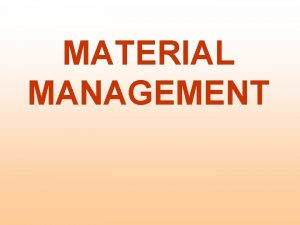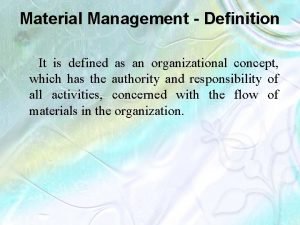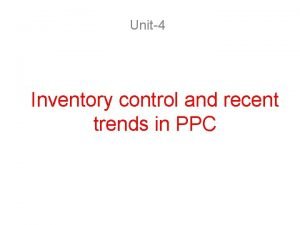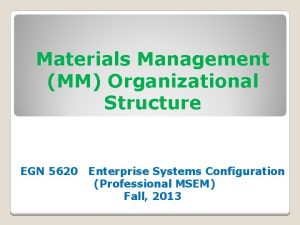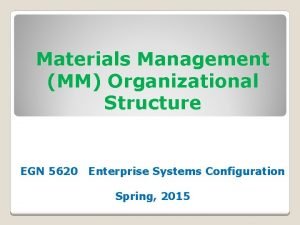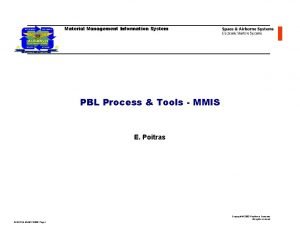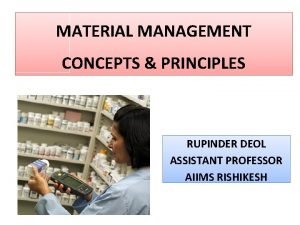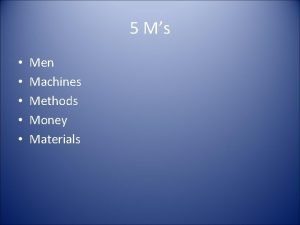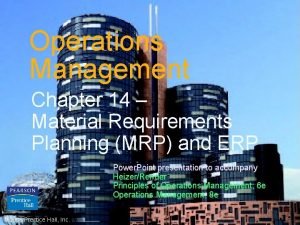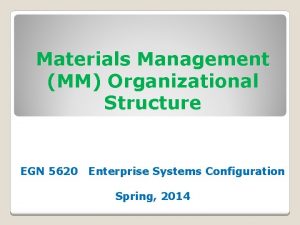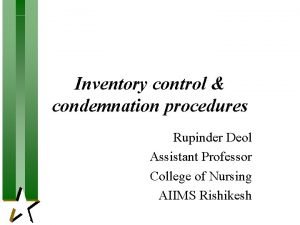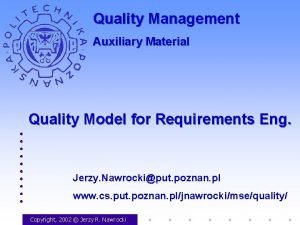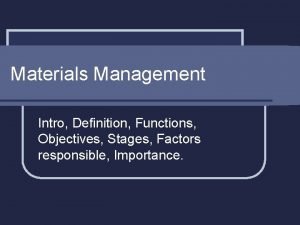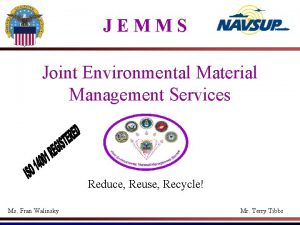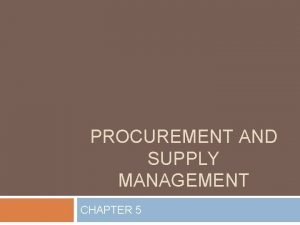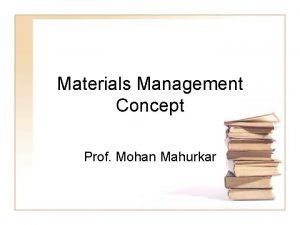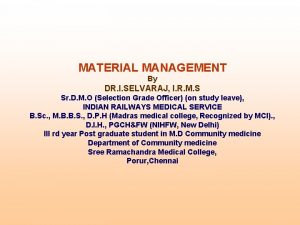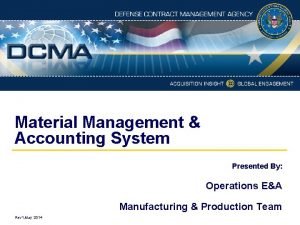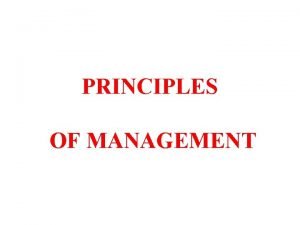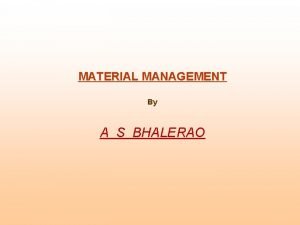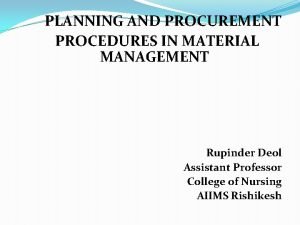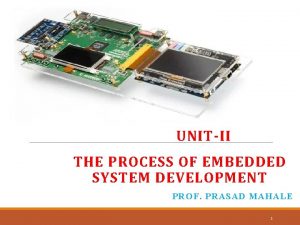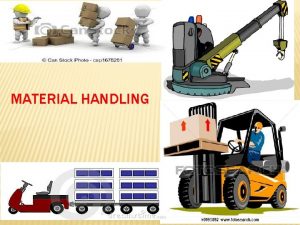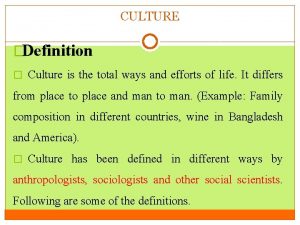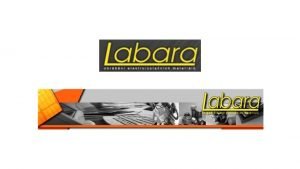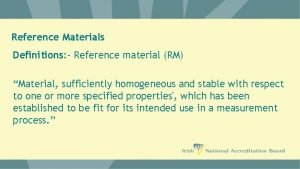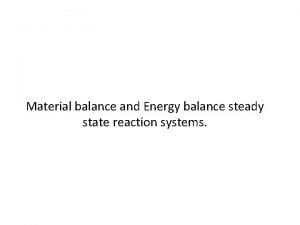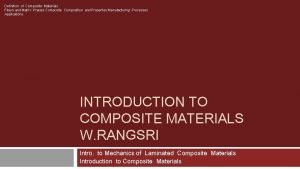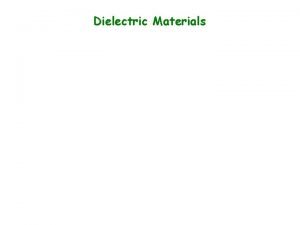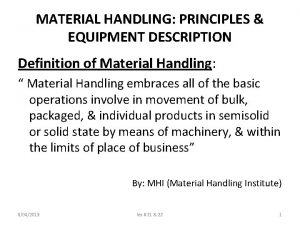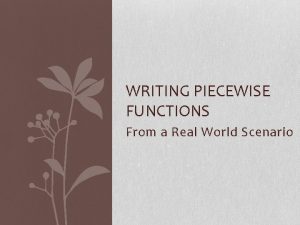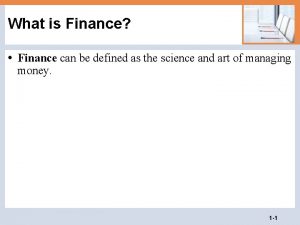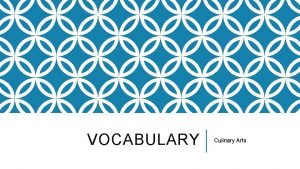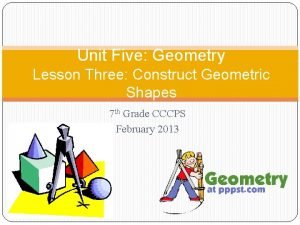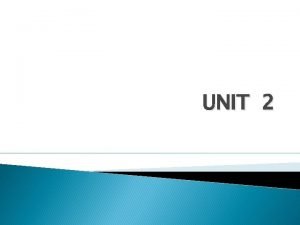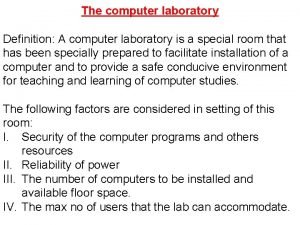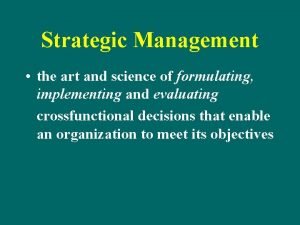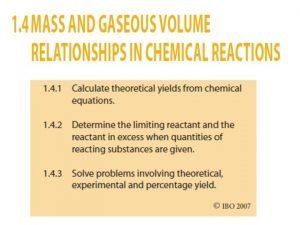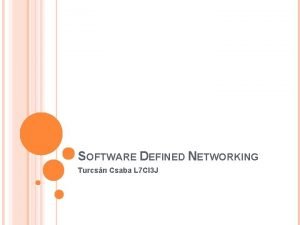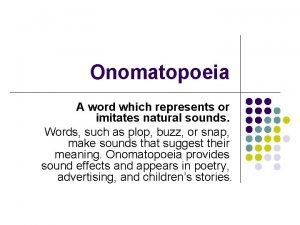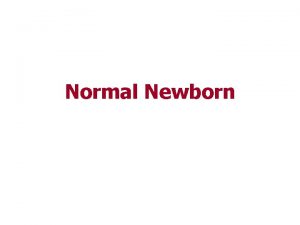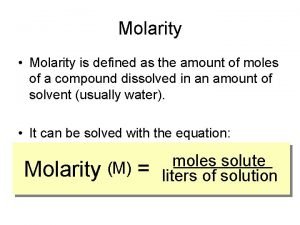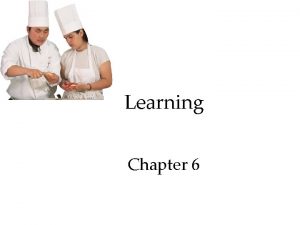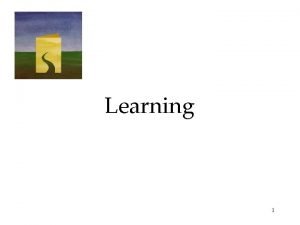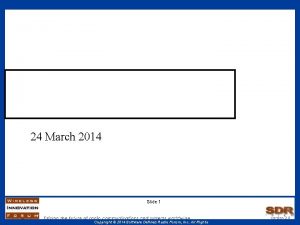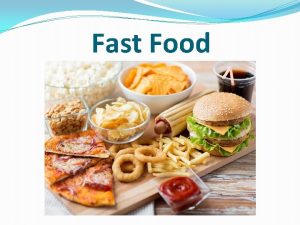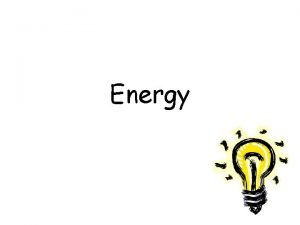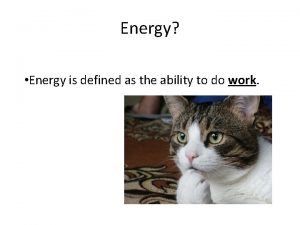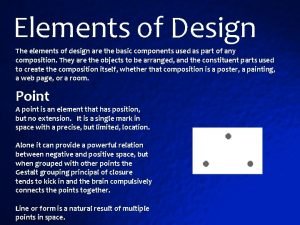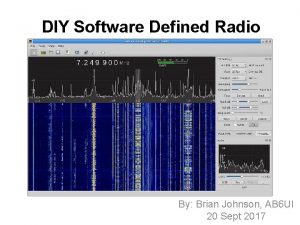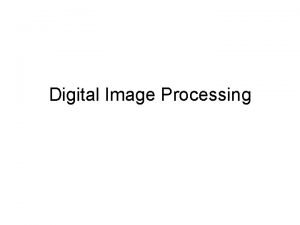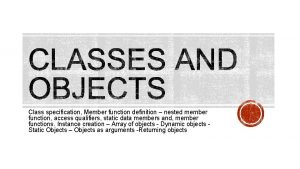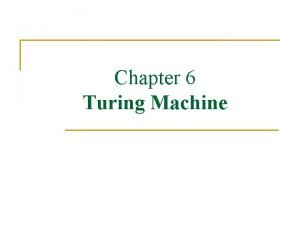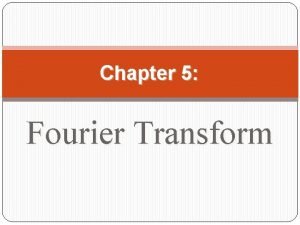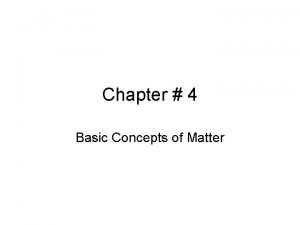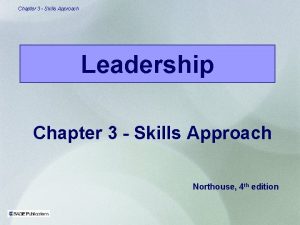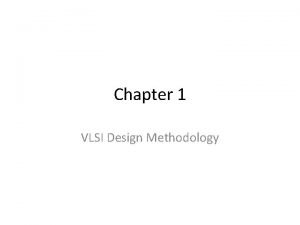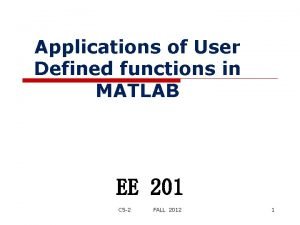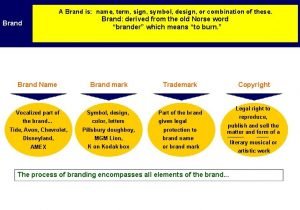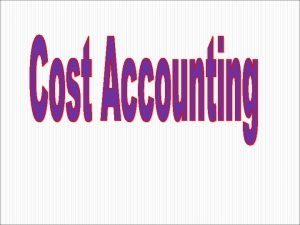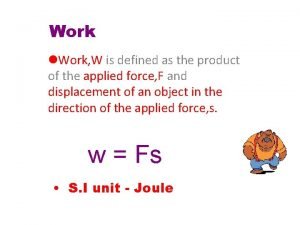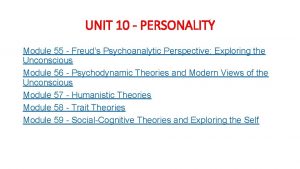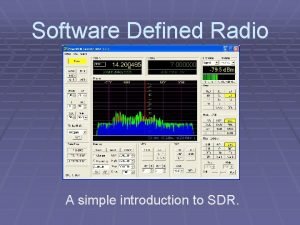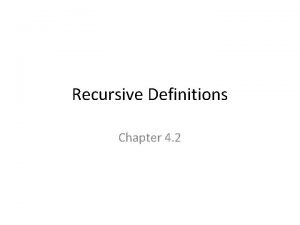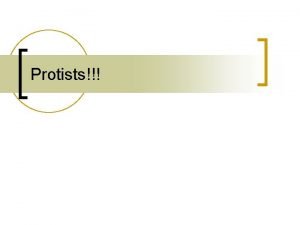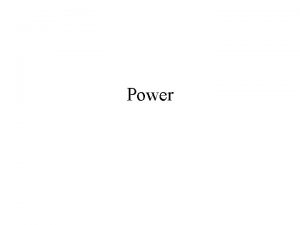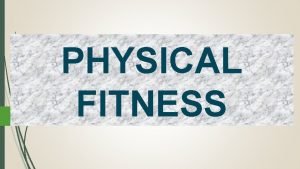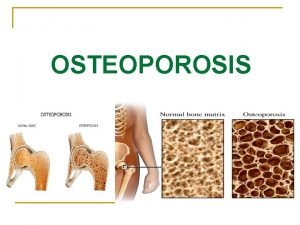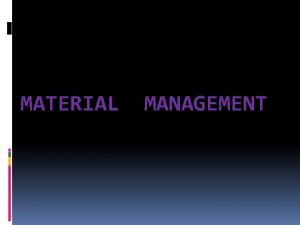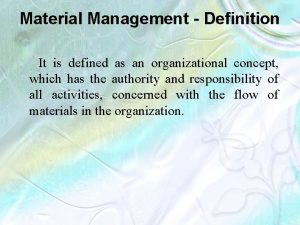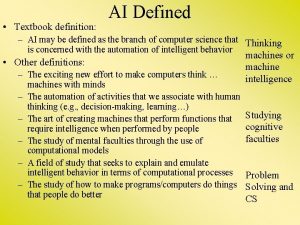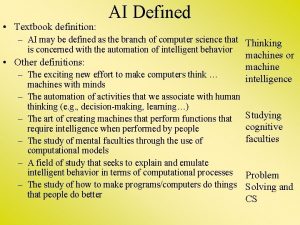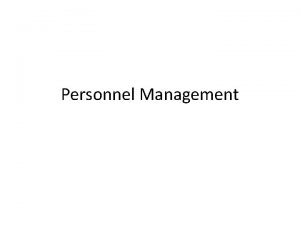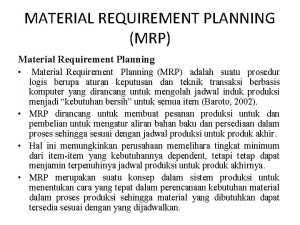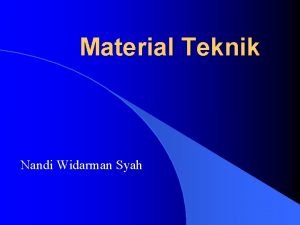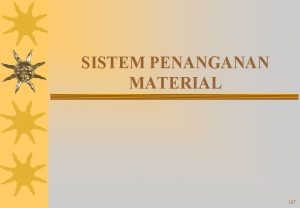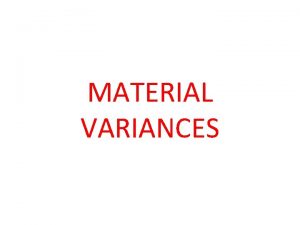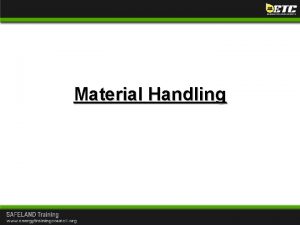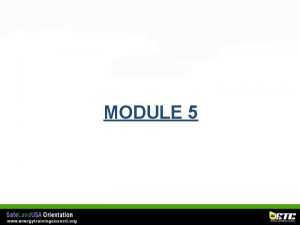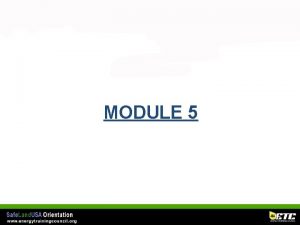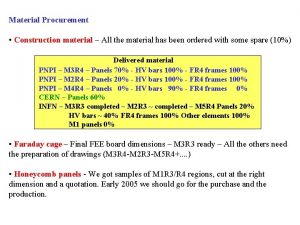Material Management Definition It is defined as an












































































































- Slides: 108

Material Management - Definition It is defined as an organizational concept, which has the authority and responsibility of all activities, concerned with the flow of materials in the organization.

Objectives and importance • Efficient use of the working capital. • Lowering inventory investment and increasing the inventory turnover. • Responding to the market changes related to any product. • Ensuring the cooperation of all departments. • Providing best services to the king of the market i. e customer.

Principles of material handling • Least handling is the best handling. • Lengths and number of move to be minimized. • Unit loads • Minimize the distance.

Principles of material handling • The design of the container. e. g. shippers are used for storing finished bulk. & for raw materials as per the property of materials they are stored- plastic containers ( light weight containers) • Re-handling and back tracking of the materials should be avoided. • The materials handling service should not interfere with the production flow.

Classes of materials • Raw materials: - These are materials that are used in the product which is in an unprocessed condition. • Purchased Parts: - These are the items used in the assembly of the product.

Classes of materials • In-progress materials: - They are called ‘work in progress’ inventories. These goods require further processing. • Finished materials: - These are fully manufactured goods, inspected and ready for delivery to the customers. • Supplies: - These are consumable goods used in the process of manufacturing.

Functions of material management

Materials-Quality & Quantity • Four factors affecting the purchase of raw materials are 1) Quality : - The suitably of an item to accomplish the intended work. The raw materials should satisfy the following requirements. i. Efficiency of the material. ii. Cost and the shelf –life. iii. For equipments, power consumption and power requirement.

Quantity • i. iii. iv. 3) 4) From the inventory point of view, quantity standards are decided on the following parameters; Maximum inventory Minimum inventory Standard order Reorder point Price Delivery Date

Value Analysis • Definition: - It is a systematic study of every element for it’s cost in a part, material or service to make certain that it performs it’s function at the lowest possible cost. • Benefits of value analysis: i. Decrease in existing cost of the product or service. ii. Unnecessary expenditure is identified and eliminated. iii. Product value improves for new materials and processes. iv. More profits.

Value ratio Mathematical representation of the value can be done as Function Total cost Value = Reasons for unnecessary costs: i. Lack of information ii. Lack of ideas iii. Changed circumstances iv. Wrong beliefs, habits and attitudes

Value Analysis Technique In this technique (n) number of questions are applied, like: o what must I do? o What else does the item do? o What does it cost? o What else will the job do? o What will be alternative costs?

Purchasing Centralized : - the purchasing procedure of materials for different department is done together from one purchasing department. This is seen in small organizations. Advantages ü Efficient system ü Bargaining capabilities increased ü Good raw material obtained at lower price Decentralized: different department purchase their requirement seperately. This is basically seen in large organizations. Advantages ü Flexible purchasing system ü Procurement is faster

Vendor development The supplier or the person who sells the required materials or services for the production is known as a vendor. The purchase of raw materials/service from a specific vendor is known as the vendor development. There are four stages of vendor development: -

Four stages of vendor development

1) Survey stage The following sources are considered for information • Trade directories : - e. g. Yellowpages. eindiabusiness. com • Trade journals: - e. g. Pharmatimes • Telephone directories • Supplier’s catalogue • Salesmen Other ways are like interchanging of information with other companies, tracing of public tenders and advertisements in the press.

2) Enquiry stage After getting the information of the suppliers, detailed analysis of the supplier is being carried out. A comparison is being made between the different suppliers on basis of the following points: - a. b. c. d. Technological competition, service competition, price competition, delivery time.

2) Enquiry stage The following aspects can be verified by the first hand visit: Ø Internal facilities of the vendor Ø Financial adequacy, stability and reputation of the vendor Ø Location of vendor’s factory Ø After sales service Ø Industrial relations

3) Negotiation and selection stage • The vendors who clear the enquiry stage are selected and negotiations are being carried out with them. • The various aspects such as credit, quantity discount, quality specifications are being discussed.

4) Experience and evaluation stage • The buyer evaluates and appraises the performance of the vendor. • The objective is to improve the performance of the vendors. Few ways of evaluating a vendor are: o Categorial method o Weighted point method o Cost ratio method

Categorial method The buyer sets up some category on which the evaluation of the vendor is done. Specimen of supplier’s evaluation form is given below. Grading Factors Supplies are as per quantity selected Deliveries are on time Rigorous follow up is not necessary Willing to accommodate when production schedules are suddenly changed Always 9 8 7 Usually 6 5 4 Seldom 3 2 1 Never 0

Weighted point method Here the rating points are divided between quality, delivery and price. For eg quality – 50 points delivery- 30 points price – 20 points so total is 100 points. The rating can be obtained by following equation.

Weighted point method Quantity rating = (no. of lots accepted/ no. lots received) ×rating points Delivery rating = (no of lots delivered on time/ no of lots delivered) × rating points Price rating =(least offer received/ supplier’s offer) × rating points

Buying techniques Purchasing of material , machinery and services is done by purchasing department. For buying the material company has to pay up a price, the value that a seller sets on his goods in the market is called as the price of that good. Price is one of the greatest variables in the purchasing of material.

How is the purchasing done? ? • Quotations : - It is a kind of an inquiry done to know whether the vendor can supply the desired material and at what price. • They are not the purchase order. They just contain all the details including freight, taxes and many other costs. • The highly used quotation techniques are • Spot quotations • Floating a limited enquire

How is the purchasing done? ? • Spot quotations: - this is basically used for the small items not related to the technical purpose. The prospective buyer goes to the market and gets the quotations from the different suppliers. • Floating a limited enquire: - this method is used when the value of the purchase is small. In this technique the reliable vendors are called upon and asked to provide the quotations.

How is the purchasing done? ? • Tenders: It is a written letter or a published document that is aimed at finding the price for procuring certain materials. Tenders are invited from recognized firms. A few types of tenders are: # single tender # Open tender # Closed tender or limited tender

How is the purchasing done? ? • Single tender: - It is invited from one reliable supplier. This kind of tender is floated only when the itms are required urgently. • Open tender: - Also known as ‘ press tender’. This is used when the value of item to be purchased is very high. It is used to locate more suppliers. In this tender procured, a small amount of the deposit money is taken from the supplier so that they do not withdraw from the submitted rates.

How is the purchasing done? ? • Closed tender or limited tender (Negotiations): - It is done to arrive at the mutual understanding between the supplier/vendor and the buyer.

How is the purchasing done? ? What’s the need for negotiation? @ prices are related to large volumes or to a large value. @ terms and conditions are required for large volumes. @ contract is desired for a longer period. @ variations in quantity to be purchase are possible. @ when supplies or services can be obtained from only one source. @ when no acceptable quotations are received from the other vendors.

How is the purchasing done? ? Process of negotiations: - It is a kind of win-win situation. Both the parties try to benefit to the maxima through the negotiation. It is not a kind of bargaining but a mutual understanding between the two parties.

How is the purchasing done? ? • Discounts: - They are cash concessions offered by the vendor to the buyer, in order to enhance the volume of the business opportunities. Reasons for offering discounts? ? ? ! When there is a bulk purchase. ! When the bills are cleared immediately. ! And also to maintain the good rapo with the buyer Types of discounts: 1) Volume contracts. 2) Deals 3) Discounts 4) Consignment terms

How is the purchasing done? ? # Volume contracts: - This kind of discount is offered proportionate to the volume of material ordered. # Cash discount: - Cash discount is given on the basis of the time of the payment done by the purchaser. The normal credit period is 90 days. # Cumulative discount: - It is a method of offering the discount on the basis of actual purchases and appropriate to the quantity range in a year.

Purchasing cycle and procedure • The purchasing department of the company is responsible for the purchase of all the raw materials as well as the requirements. The following steps are followed in the purchasing cycle. 1) Recognition of need and receipt of requisition: The requisition includes the following information: - Name - Quality and quantity specifications - Date by which material is required - Place at which material is to be delivered

Purchasing cycle and procedure 2) Selection of potential sources of supply 3) Making request for quotation 4) Receipt and analysis of quotations - material specifications and quality - price of the material - taxes - terms of payemeny - place of delivery - delivery period - gurantee period - validity of tender

Purchasing cycle and procedure 5) Selection of right source of supply 6) Issuing the purchase order 7) Follow-up of the order 8) Receipt of materials, reports and analysis 9) Checking and approving of vendor’s invoice for payment 10) Closing of completed order 11) Maintenance of record and file Purchasing cycle flow chart has been given in the following slide.

Need recognition Spell out of specifications & requirements Official requisitions Check specifications, prices/supplies Specifications file Inquiry tender Select suppliers Purchase records Supplier’s record Quotations & analysis prices and terms, negotiations, finalisation Purchase order for supply Follow-up Suppliers’ acceptance

• Contd …. Delivery of materials Checking of invoice with purchase order Materials & reports, analysis Payment made

Example of Materials and People Flow

Location of Stores : § Store should be located adjacent to the manufacturing area. §It depends up on nature and value of items to be stored and frequency with which items are received and issued Objectives : ü Minimum wastage of space ü Maximum ease of operation ü Minimum handling cost ü Minimum other operational cost

Facilities of Store q. Inspection center q. Quarantine room q. Washing room q. Centralized weighing department q. Adequate space

Functions of stores General function : Ø Maintenance of Stock (materials and tools) Ø Maintenance of hygiene, sanitation, and pest control Ø Maintenance of material handling equipment

Functions of stores Specific functions : q Receiving & recording of raw materials q Quarantine storage – Sampling & approval by QC q Positioning & Storage q Issuing & recording of materials q Receiving & Dispatching of finished goods q Distribution Optional functions : q Dispensing, Maintenance of weights & measures

Material handling system q. Right Definition : Material handling uses the right method to provide the right amount of the right material at the right place, at the right time, in the right sequence, in the right position, in the right condition, and at the right cost.

Material handling system Involves handling, storing, and controlling material • The raw materials, in-process materials and finished goods are moved from one place to another in the plant. • Adds value through time and place utility • Impacts space requirement, profits, quality, safety, and productivity • On an average, 20% of production cost is spent on material handling system

Twenty Principles of Material Handling 1. Planning principle. Plan all material handling and storage activities to obtain maximum overall operating efficiency. 2. System principle. Integrate as many handling activities as is practical into a coordinated system of operations, covering vendor, receiving, storage, production, inspection, packaging, warehousing, transportation. etc.

Twenty Principles of Material Handling 3. Material flow principle. Provide an operation sequence and equipment layout optimizing material flow. 4. Simplification principle. Simplify handling by reducing, eliminating, or combining unnecessary movement and/or equipment. 5. Gravity principle. Utilize gravity to move material wherever practical.

Twenty Principles of Material Handling 6. Space utilization principle. Make optimum utilization of space. 7. Unit size principle. Increase the quantity, size, or weight of unit loads or flow rate. 8. Mechanization principle. Mechanize handling operations.

Twenty Principles of Material Handling 9. Automation principle. Provide automation to include production, handling, and storage functions. 10. Equipment selection principle. In selecting handling equipment, consider all aspects of the material being handled.

Twenty Principles of Material Handling 11. Standardization principle. Standardize handling methods as well as types and sizes of handling equipment. 12. Adaptability principle. Use methods and equipment that can best perform a variety of tasks and applications where special purpose equipment is not justified.

Twenty Principles of Material Handling 13. Dead weight principle. Reduce ratio of dead weight of mobile handling equipment to load carried. 14. Utilization principle. Plan for optimum utilization of handling equipment and manpower. 15. Maintenance principle. Plan for preventive maintenance and scheduled repairs of all handling equipment.

Twenty Principles of Material Handling 16. Obsolescence principle. Replace obsolete handling methods and equipment when more efficient methods or equipment will improve operations. 17. Control principle. Use material handling activities to improve control of production inventory and order handling.

Twenty Principles of Material Handling 18. Capacity principle. Use handling equipment to help achieve desired production capacity. 19. Performance principle. Determine effectiveness of handling performance in terms of expense per unit handled. 20. Safety principle. Provide suitable methods and equipment for safe handling.

Handling of materials must be performed q q q Safely Efficiently At low cost In a timely manner Accurately (the right materials in the right quantities to the right locations) q And without damage to the materials

Risks associated with improper handling • Increase in cost of raw material and finished products • Delay in production schedule and long production cycle • Waste of machine time and personnel time • Increase in in-process inventories • Damage or loss of material and employee safety liabilities • Employee frustration and reduced morale • Customers dissatisfaction

Selecting Material Handling Systematic Approach 1. Define the problem

Selecting Material Handling System 2. Analyze the problem Observe activities Obtain layouts, flow patterns, schedules, etc. Obtain information on existing material handling equipment Analyze situation by Twenty Principles of Material Handling, and/or forms Can activities be combined, simplified, eliminated? ? ?

Selecting Material Handling System 3. Identify possible solutions Organize meeting with: material handlers machine operators supervisors support engineers 4. Evaluate alternatives Meet again to rate alternatives

Material Handling Equipment Five categories: 1. Industrial trucks 2. Automated guided vehicles 3. Monorails and other rail guided vehicles 4. Conveyors 5. Cranes and hoists

Industrial Trucks Two basic categories: 1. Non-powered – Human workers push or pull loads 2. Powered – Self-propelled, guided or driven by human – Common example: forklift truck

Nonpowered Industrial Trucks (Hand Trucks) (a) Two-wheel hand truck, (b) four-wheel dolly, (c) hand-operated low-lift pallet truck

Powered Trucks Capacities from 450 kg up to 4500 kg Power sources include on-board batteries and internal combustion motors

Powered Trucks • Designed to pull one or more trailing carts in factories and warehouses, as well as for airport baggage handling • Powered by onboard batteries or IC engines

Automated Guided Vehicles An Automated Guided Vehicle System (AGVS) is a material handling system that uses independently operated, selfpropelled vehicles guided along defined pathways in the facility floor • Types of AGV: – Driverless trains – Pallet trucks – Unit load AGVs

Driverless Automated Guided Train • First type of AGVS to be introduced around 1954 • Common application is moving heavy loads over long distances in warehouses and factories without intermediate stops along the route

AGV Pallet Truck • Used to move palletized loads along predetermined routes • Vehicle is backed into loaded pallet by worker; pallet is then elevated from floor • Worker drives pallet truck to AGV guide path and programs destination

Unit Load Carrier • Used to move unit loads from station to station • Often equipped for automatic loading/unloading of pallets and pans using roller conveyors, moving belts, or mechanized lift platforms

AGVs Applications 1. Driverless train operations - movement of large quantities of material over long distances 2. Storage and distribution - movement of pallet loads between shipping/receiving docks and storage racks 3. Assembly line operations - movement of car bodies and major subassemblies (motors) through the assembly stations 4. Flexible manufacturing systems - movement of work parts between machine tools 5. Miscellaneous

Rail-Guided Vehicles • Self-propelled vehicles that ride on a fixed-rail system • Vehicles operate independently and are driven by electric motors that pick up power from an electrified rail • Fixed rail system – Overhead monorail - suspended overhead from the ceiling – On-floor - parallel fixed rails, tracks generally protrude up from the floor

Overhead Monorail

Conveyor Systems • Large family of material transport equipment designed to move materials over fixed paths, usually in large quantities or volumes 1. Non‑powered : Materials moved by human workers or by gravity 2. Powered : Power mechanism for transporting materials is contained in the fixed path, using chains, belts, rollers or other mechanical devices

Conveyor Types • • • Roller Skate‑wheel Belt In‑floor towline Overhead trolley conveyor

Roller In‑floor towline Skate‑wheel Belt Overhead trolley conveyor

Cranes and Hoists Handling devices for lifting, lowering and transporting materials, often as heavy loads • Cranes – Used for horizontal movement of materials • Hoists – Used for vertical lifting of materials • Cranes usually include hoists so that the crane-and -hoist combination provides – Horizontal transport – Vertical lifting and lowering

Hoist Load

Bridge Crane Gantry Crane Jib Crane

Salvaging and Disposal of Scrap and Surplus The words ‘Scrap’ and ‘Surplus’ symbolize waste and to that extent these account for the loss of profits. Scrap is commonly used for waste of all kinds.

q. These occur for the following reasons: Ø Mistakes in procurement Ø Wrong planning decisions Ø Wasteful processes in production Ø Inevitable waste during the adjustment of the equipment Ø Overall absence of efficiency

q Disposal of scrap, surplus, recyclable, obsolete materials is one of the most important area of materials management, but often overlooked or considered minor. q Popular due to increased public awareness of environment, government legislation, better recognition of opportunities it offers in return. e. g. paper files and forms are recyclable item that can be sold to recycle company.

The following measure adopted and monitored for handling scrap: 1. Controlling of surplus and scrap 2. salvaging or converting the waste for advantageous use. 3. Disposal of the surplus and scrap to the best advantage.

The production department primarily controls the first function by proper design, while purchase department handles the second and third functions. Waste materials in pharmaceutical industry: • Empty drums, packing materials, card boards, aluminium caps, bottles etc. these are nonrecoverable rejects. • Spoiled materials during production. In a few instances, these may be recoverable. • Worn-out parts of equipments (examples are punches and dies), old equipment (due to expiry of life) and obsolete equipment (due to technology change).

Salvage : It is defined as the processing of materials (items) for advantageous use or disposal of company property, which is no longer economically useful in its present position. Salvage operation : Ø Waste materials are properly collected and stored at one place continuously, so that these can form a separate batch in production. Ø Recoverable materials are stored in a scientific way as other items stored.

Ø Materials are stored in terms of quality or size or specifications. Ø Waste is invested for suitability to recover or avoid them. q Salvaging operation are possible under the following conditions: Ø Evidences from laboratory tests and assays that the drug products meet all applicable standards of identity, strength, quality and purity. Ø Evidence from inspection of premises that the drug products and their associated packing were not subjected to improper storage condition, as a result of the disaster or accident.

Disposal of scrap, waste and surplus materials can be effected by several way : Ø Surplus material should be returned to the original supplier. Alternatively a customer who needs them should be explored. Ø As a social obligation, some material are defected or broken before selling them as scrap.

Disposal Ø Materials may be sold by inviting quotations from potential buyers or through various contracts such as fixed price contract, varying price contract, specific bids and negotiations. • It is worth considering that scrap like any other material represents money and to that extent it has a value.

Unit lode, Pelletization and Containerization q Unit load is a set of items (raw material, semi finished parts, finished product) to be move together, like: § A set of cartons on a pallet § A set of products in a container q Ø Ø Ø In a unit load, parts are In something (In a carton) On something (On a pallet) Grouped by something (wrapped, strapped)

Reasons for using unit loads in material handling Multiple items handled simultaneously Required number of trips is reduced Loading/unloading times are reduced Product damage is decreased (a) Wooden pallet, (b) pallet box, (c) tote box

q Pallets : Style and Size based on: Ø Shipping and receiving restrictions Ø Size and weight of items on the pallet Ø Space restrictions Ø Equipment used to move the pallet Ø Cost, supply, and maintenance Ø Aisle widths, door sizes, stacking heights

q Types of Pallets : q Materials used : • Softwood • Hardwood • Paper • Plastic • Steel • Aluminium

q. Containerization : Different types of containers are used according to the type of material. e. g Boxes, cartons, cases, sacks, bales, pallets, drums, barrels, crates, cable drums, machinery, and processed timber Tank containers for bulk liquids and dangerous goods.

Advantages of material management • It eliminates unproductive handling of the materials like back-tracking, rehandling etc. • It reduces idle machine capacity and thus ensures better turnover on investment. • It reduces considerably the idle time of the workers.

Advantages of material management • The quality of the materials is also maintained through minimum human touches, elimination of breakages, etc. • Every inch of the factory space is properly utilized. • The issue of materials is also facilitated. • It helps in maintaining effective production planning and control.

Advantages of material management • Reduced operating costs and timely production. • Greater job satisfaction on the part of both the workers and the employer.

COST REDUCTION “Cost cutting is no longer the solution to sustainable profitability, the key to success is finding creative ways to prevent cost. ”

DEFINITION “Cost reduction is to be understood as the achievement of real and permanent reductions in the unit cost of the goods manufactured or services rendered without impassing their suitability for the use that is intended”- ICWA London.

Achieving the goals of cost reduction § Reducing the cost per unit. § Increasing productivity. How to reduce cost? § § § Elimination of waste Improving operations. Increasing Productivity. Cheaper materials. Improved Standards of Quality.

Cost Reduction Process 1) 2) 3) 4) 5) Analysis Examination. Developing Solution. Selecting a solution. Obtaining agreement.

Fish. Bone Diagram:

Areas of Cost Reduction 1. a) b) c) d) e) 2) 3) a) b) c) Material: Design. Purchasing. Storage. Transport. Production. Labour: Overheads: Increasing the production volume. Extension of market and price differentials. Size of business units.

4. Outsourcing 5. Sales and marketing 6. Energy 7. Production

3 dimensions of Cost reduction 1)Internally driven: -Keep improving processes -Employee suggestion programs 2)Externally driven : -Top of the technology and process 3)Competitor driven: -Benchmarking against competitors -Real time data

Implementing Cost reduction program • Set realistic goals • Develop cost reduction program consulting all • Do an ROI analysis • Explore all options, not only BPR/technology(consider offshoring and outsourcing

Tools and Techniques of Cost Reduction 1. 2. 3. 4. 5. 6. 7. 8. 9. Value Analysis. Work Study. Job Evaluation and merit rating. Quality Control. Economic Order Quantity. Use of Better Technology. Standardization. Improvement in the design of a product. Inventory Management and Control.

Advantages of Cost Reduction A. § § § To a particular concern Improves profits. Improves financial position. Improves competitive capabilities. § Serves as an index of efficiency. B. To the Industry § One company serves as a trend setter for the other companies.

C. To the Nation § Efficient utilization of Scarce Resources. § High taxes can be levied by the government. § Retaining the markets and gaining new buyers. § Combating inflation.

Cost reduction in materials in Manufacturing setup. 1. 2. 3. 4. Vendor consolidation. Value engineering. Assembly outsourcing Standardization.

1) 2) 3) 4) 5) 6) Precautions in Implementations Must be planned soundly. Appropriate to organization. Requires cooperation and coordinated efforts. Reluctance should be recognized and dealt with. Programs should be clearly communicated. Should not have undesirable effects on external parties. 7) Unnecessary costs can be reduced not eliminated. 8) Is expensive and complicated to implement.

 Basic needs of material management
Basic needs of material management Function of purchase department
Function of purchase department Well defined objects
Well defined objects Concentricity tolerance chart
Concentricity tolerance chart Material yield variance formula
Material yield variance formula Examples of popular culture
Examples of popular culture Material and non material culture examples
Material and non material culture examples All groups create norms to enforce their cultural values.
All groups create norms to enforce their cultural values. Are all the materials useful
Are all the materials useful What is operations management
What is operations management Piecewise function explanation
Piecewise function explanation Top management and middle management
Top management and middle management Top management middle management first line management
Top management middle management first line management Middle level management
Middle level management Abc analysis in material management
Abc analysis in material management Material management organization structure
Material management organization structure Warehouse management structure
Warehouse management structure Material management information system
Material management information system Principles of material management
Principles of material management 5m money man machine
5m money man machine Product structure tree example
Product structure tree example Material management organization structure
Material management organization structure Condemnation in material management
Condemnation in material management Material quality management
Material quality management Objectives and functions of material management
Objectives and functions of material management Kadena recycle center
Kadena recycle center Material management
Material management Objectives of material management
Objectives of material management Condemnation and disposal in material management
Condemnation and disposal in material management Material management and accounting system
Material management and accounting system Conclusion of material management
Conclusion of material management Bhalerao
Bhalerao Material management planning and procurement
Material management planning and procurement Raw material definition
Raw material definition Manual material handling definition
Manual material handling definition Culture is dynamic example
Culture is dynamic example Composite material definition
Composite material definition Reference material definition
Reference material definition Steady state material balance
Steady state material balance Composite material definition
Composite material definition Dielectric material definition
Dielectric material definition Material goods definition
Material goods definition Dead weight principle in material handling
Dead weight principle in material handling Piecewise function real life
Piecewise function real life Definition work physics
Definition work physics Finance
Finance Rondelle definition cooking
Rondelle definition cooking Usability quality attribute that assesses
Usability quality attribute that assesses Task conflict
Task conflict Ambiguously defined triangle
Ambiguously defined triangle Concept of learning ppt
Concept of learning ppt Rotter mischel
Rotter mischel What is a computer laboratory
What is a computer laboratory The art and science of formulating
The art and science of formulating Stoichiometry
Stoichiometry Stoichiometry is the study of
Stoichiometry is the study of 7 ci
7 ci Sdn and traditional networking
Sdn and traditional networking Which greek philosopher defined the art of persuasion
Which greek philosopher defined the art of persuasion Sql user defined table
Sql user defined table Terrestrial biomes definition
Terrestrial biomes definition Onomatopoeia sentence
Onomatopoeia sentence Suprasternal retraction
Suprasternal retraction Molarity image
Molarity image Light may be defined as
Light may be defined as Learning is defined as
Learning is defined as Is learning relatively permanent
Is learning relatively permanent Software defined radio forum
Software defined radio forum The simplest or the literal definition of photography.
The simplest or the literal definition of photography. Extrication is defined as
Extrication is defined as Heart failure definition
Heart failure definition Health education defintion
Health education defintion Geothermal def
Geothermal def Fast food can be defined as any food that contributes
Fast food can be defined as any food that contributes Energy is defined as
Energy is defined as Energy is defined as the ability to
Energy is defined as the ability to Is an element defined by its perimeter a closed contour
Is an element defined by its perimeter a closed contour Diy sdr receiver
Diy sdr receiver Plane transmission grating is
Plane transmission grating is Image negatives a gray level transformation is defined as
Image negatives a gray level transformation is defined as Member function definition
Member function definition A trait is formally defined as a
A trait is formally defined as a Formal definition of turing machine
Formal definition of turing machine Fourier transform is defined for
Fourier transform is defined for Work done define
Work done define Matter is defined as anything that
Matter is defined as anything that The skills approach is primarily
The skills approach is primarily A behavioral crisis is most accurately defined as
A behavioral crisis is most accurately defined as Y chart in vlsi
Y chart in vlsi Mathematics
Mathematics User defined function matlab
User defined function matlab A fuel's net energy yield is correctly defined as
A fuel's net energy yield is correctly defined as Allusions are defined as
Allusions are defined as Name terms sign symbol is known as
Name terms sign symbol is known as Cost management meaning
Cost management meaning Recursively defined functions
Recursively defined functions Find two functions defined implicitly by the given relation
Find two functions defined implicitly by the given relation Work is defined as
Work is defined as How is personality defined module 55
How is personality defined module 55 Timer 8051
Timer 8051 Is the great wall of china superimposed boundary
Is the great wall of china superimposed boundary Introduction to software defined radio
Introduction to software defined radio Principle of recursive definition
Principle of recursive definition Protists
Protists Abstractions for software defined networks
Abstractions for software defined networks How is power defined
How is power defined Situational poverty definition
Situational poverty definition The ability to do strength work at an explosive pace
The ability to do strength work at an explosive pace Osteoporosis definition
Osteoporosis definition
